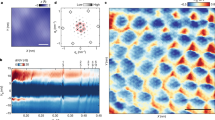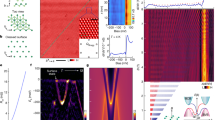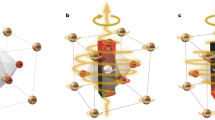Abstract
The single-layered ruthenate Sr2RuO4 is presented as a potential spin-triplet superconductor with an order parameter that may break time-reversal invariance and host half-quantized vortices with Majorana zero modes. Although the actual nature of the superconducting state is still a matter of controversy, it is believed to condense from a metallic state that is well described by a conventional Fermi liquid. In this work we use a combination of Fourier transform scanning tunnelling spectroscopy (FT-STS) and momentum-resolved electron energy loss spectroscopy (M-EELS) to probe interaction effects in the normal state of Sr2RuO4. Our high-resolution FT-STS data show signatures of the β-band with a distinctly quasi-one-dimensional (1D) character. The band dispersion reveals surprisingly strong interaction effects that dramatically renormalize the Fermi velocity, suggesting that the normal state of Sr2RuO4 is that of a ‘correlated metal’ where correlations are strengthened by the quasi-1D nature of the bands. In addition, kinks at energies of approximately 10 meV, 38 meV and 70 meV are observed. By comparing STM and M-EELS data we show that the two higher energy features arise from coupling with collective modes. The strong correlation effects and the kinks in the quasi-1D bands could provide important information for understanding the superconducting state.
This is a preview of subscription content, access via your institution
Access options
Access Nature and 54 other Nature Portfolio journals
Get Nature+, our best-value online-access subscription
$29.99 / 30 days
cancel any time
Subscribe to this journal
Receive 12 print issues and online access
$209.00 per year
only $17.42 per issue
Buy this article
- Purchase on Springer Link
- Instant access to full article PDF
Prices may be subject to local taxes which are calculated during checkout




Similar content being viewed by others
References
Byczuk, K. et al. Kinks in the dispersion of strongly correlated electrons. Nat. Phys. 3, 168–171 (2007).
Carbotte, J. P., Timusk, T. & Hwang, J. Bosons in high-temperature superconductors: an experimental survey. Rep. Prog. Phys. 74, 066501 (2011).
Lanzara, A. et al. Evidence for ubiquitous strong electron–phonon coupling in high-temperature superconductors. Nature 412, 510–514 (2001).
Aiura, Y. et al. Kink in the dispersion of layered strontium ruthenates. Phys. Rev. Lett. 93, 117005 (2004).
Mackenzie, A. P. & Maeno, Y. The superconductivity of Sr2RuO4 and the physics of spin-triplet pairing. Rev. Mod. Phys. 75, 657–712 (2003).
Kallin, C. Chiral p-wave order in Sr2RuO4 . Rep. Prog. Phys. 75, 042501 (2012).
Jang, J. et al. Observation of half-height magnetization steps in Sr2RuO4 . Science 331, 186–188 (2011).
Bergemann, C. Quasi-two-dimensional Fermi liquid properties of unconventional superconductor Sr2RuO4 . Adv. Phys. 52, 639–725 (2003).
Liebsch, A. & Lichtenstein, A. Photoemission quasiparticles spectra of Sr2RuO4 . Phys. Rev. Lett. 84, 1591–1594 (2000).
Kidd, T. E. et al. Orbital dependence of the Fermi liquid state in Sr2RuO4 . Phys. Rev. Lett. 94, 107003 (2005).
Stricker, D. et al. Optical response of Sr2RuO4 reveals universal Fermi-liquid scaling and quasiparticles beyond Laudau theory. Phys. Rev. Lett. 113, 087404 (2014).
Zhang, G., Gorelov, E., Sarvestani, E. & Pavarini, E. Fermi surface of Sr2RuO4: spin-orbit and anisotropic Coulomb interaction effects. Phys. Rev. Lett. 116, 106402 (2016).
Iwasawa, H. et al. Interplay among Coulomb interaction, spin–orbital interaction, and multiple electron–boson interactions in Sr2RuO4 . Phys. Rev. Lett. 105, 226406 (2010).
Veenstra, C. N. et al. Spin-orbital entanglement and the breakdown of singlets and triplets in Sr2RuO4 revealed by spin- and angle-resolved photoemission spectroscopy. Phys. Rev. Lett. 112, 127002 (2014).
Damascelli, A. et al. Fermi surface, surface states, and surface reconstruction in Sr2RuO4 . Phys. Rev. Lett. 85, 5194–5197 (2000).
Rice, T. M. & Sigrist, M. Sr2RuO4: a electronic analogue of 3He? J. Phys. Condens. matter 7, L643–L648 (1995).
Raghu, S., Kapitulnik, A. & Kivelson, S. A. Hidden quasi-one-dimensional superconductivity in Sr2RuO4 . Phys. Rev. Lett. 105, 136401 (2010).
Firmo, I. A. et al. Evidence from tunneling spectroscopy for a quasi-one-dimensional origin of superconductivity in Sr2RuO4 . Phys. Rev. B 88, 134521 (2013).
Wang, Q. H. et al. Theory of superconductivity in a three-orbital model of Sr2RuO4 . Euro. Phys. Lett. 104, 17013 (2013).
Scaffidi, T., Romers, J. C. & Simon, S. H. Pairing symmetry and dominant band in Sr2RuO4 . Phys. Rev. B 89, 220510(R) (2014).
Iwasawa, H. et al. Orbital selectivity of the kink in the dispersion of Sr2RuO4 . Phys. Rev. B 72, 104514 (2005).
Burganov, B. et al. Strain control of fermiology and many-body interaction in two dimensional ruthenates. Phys. Rev. Lett. 116, 197003 (2016).
Ingle, N. J. et al. Quantitative analysis of Sr2RuO4 angle-resolved photoemission spectra: many-body interactions in a model Fermi liquid. Phys. Rev. B 72, 205114 (2005).
Kim, C. et al. Self-energy analysis of multiple-bosonic mode coupling in Sr2RuO4 . J. Phys. Chem. Solids 72, 556–558 (2011).
Hoffman, J. E. et al. Imaging quasiparticle interference in Bi2Sr2CaCu2O8+δ . Science 297, 1148–1151 (2002).
Allan, M. P. et al. Imaging Cooper pairing of heavy fermions in CeCoIn5 . Nat. Phys. 9, 468–473 (2013).
Zhou, B. B. et al. Visualizing nodal heavy fermion superconductivity in CeCoIn5 . Nat. Phys. 9, 474–479 (2013).
Lee, J. et al. Heavy d-electron quasiparticle interference and real-space electronic structures of Sr3Ru2O7 . Nat. Phys. 5, 800–804 (2009).
Kogar, A., Vig, S., Gan, Y. & Abbamonte, P. Temperature-resolution anomalies in the reconstruction of time dynamics from energy-loss experiments. J. Phys. B: At. Mol. Opt. Phys. 47, 124034 (2014).
Pennec, Y. et al. Cleaving-temperature dependence of layered-oxide surfaces. Phys. Rev. Lett. 101, 216103 (2008).
Matzdorf, R. et al. Ferromagnetism stabilized by lattice distortion at the surface of the p-wave superconductor Sr2RuO4 . Science 289, 746–748 (2000).
Stöger, B. et al. High chemical activity of a perovskite surface: reaction of CO with Sr3Ru2O7 . Phys. Rev. Lett. 113, 116101 (2014).
Barker, B. I. et al. STM studies of individual Ti impurity atoms in Sr2RuO4 . Physica B 329–333, 1334–1335 (2003).
Hlobil, P. et al. Tracing the electronic pairing glue in unconventional superconductors via inelastic scanning tunneling spectroscopy. Phys. Rev. Lett. 118, 167001 (2017).
Fradkin, E. Field Theories of Condensed Matter Systems (Cambridge Univ. Press, 2013).
Veenstra, C. N. et al. Determining the surface-to-bulk progression in the normal-state electronic structure of Sr2RuO4 by angle-resolved photoemission and density functional theory. Phys. Rev. Lett. 110, 097004 (2013).
Liu, S. Y. et al. Fermi surface sheet-dependent band splitting in Sr2RuO4 revealed by high-resolution angle-resolved photoemission spectroscopy. Phys. Rev. B 86, 165112 (2012).
Zabolotnyy, V. B. et al. Surface and bulk electronic structure of the unconventional superconductor Sr2RuO4: unusual splitting of the β band. New J. Phys. 14, 063039 (2012).
Iwasawa, H. et al. High-energy anomaly in the band dispersion of the ruthenate superconductor. Phys. Rev. Lett. 109, 066404 (2012).
Carlson, E. W., Orgad, D., Kivelson, S. A. & Emery, V. J. Dimensional crossover in quasi-one-dimensional and high-TC superconductors. Phys. Rev. B 62, 3422–3437 (2000).
Biermann, S., Georges, A., Lichtenstein, A. & Giamarchi, T. Deconfinement transition and Luttinger to Fermi liquid crossover in quasi-one-dimensional systems. Phys. Rev. Lett. 87, 276405 (2001).
Sidis, Y. et al. Evidence for incommensurate spin fluctuations in Sr2RuO4 . Phys. Rev. Lett. 83, 3320–3323 (1999).
Allan, M. P. et al. Identifying the ‘fingerprint’ of antiferromagnetic spin fluctuations in iron pnictide superconductors. Nat. Phys. 11, 177–182 (2015).
Lawler, M. J. et al. Intra-unit-cell electronic nematicity of the high-TC copper-oxide pseudogap states. Nature 466, 347–351 (2010).
Acknowledgements
We thank Z. Wang, H. Lin, J.C. Davis and S. Kivelson for useful conversations. STM work was supported by US Department of Energy, Scanned Probe Division under Award Number DE-SC0014335. The work was supported in part by the Gordon and Betty Moore Foundation’s EPiQS Initiative through Grant GBMF4860. Y.M. acknowledges the support from the JSPS KAKENHI Grant No. JP15H05852. Theoretical work was supported in part by the Gordon and Betty Moore Foundation’s EPiQS Initiative through Grant No. GBMF4305 at the Institute for Condensed Matter Theory of the University of Illinois (L.H.S. and Y.W.), and by a grant of the National Science Foundation No. DMR1408713 at the University of Illinois (E.F.). M-EELS experiments were supported by the Center for Emergent Superconductivity, DOE #DE-AC02-98CH10886. P.A. acknowledges support from Gordon and Betty Moore Foundation’s EPiQS Initiative through Grant GBMF4542. T.S. acknowledges the financial support of the Clarendon Fund Scholarship, the Merton College Domus and Prize Scholarships, and the University of Oxford.
Author information
Authors and Affiliations
Contributions
Z.W. and D.W. contributed equally to this work. Z.W., D.W. and V.M. designed the STM experiments, analysed the data and wrote the paper. STM experiments were performed by D.W., Z.W. and I.Z. Y.M. was responsible for single-crystal growth and structural analysis. A.D. helped with conceiving the experiment, data analysis and comparison with ARPES. E.F., L.H.S. and Y.W. conceived the theoretical explanation for this work. P.D., and T.S. performed analytical model calculations. M.R., S.V., A.K., A.H. and P.A. were involved in the M-EELS studies.
Corresponding author
Ethics declarations
Competing interests
The authors declare no competing financial interests.
Supplementary information
Supplementary information
Supplementary information (PDF 1941 kb)
Rights and permissions
About this article
Cite this article
Wang, Z., Walkup, D., Derry, P. et al. Quasiparticle interference and strong electron–mode coupling in the quasi-one-dimensional bands of Sr2RuO4. Nature Phys 13, 799–805 (2017). https://doi.org/10.1038/nphys4107
Received:
Accepted:
Published:
Issue Date:
DOI: https://doi.org/10.1038/nphys4107
This article is cited by
-
Pines’ demon observed as a 3D acoustic plasmon in Sr2RuO4
Nature (2023)
-
Quasi-particle interference of the van Hove singularity in Sr2RuO4
npj Quantum Materials (2021)
-
Direct comparison of ARPES, STM, and quantum oscillation data for band structure determination in Sr2RhO4
npj Quantum Materials (2020)
-
Fermion–boson many-body interplay in a frustrated kagome paramagnet
Nature Communications (2020)
-
Dictionary learning in Fourier-transform scanning tunneling spectroscopy
Nature Communications (2020)



